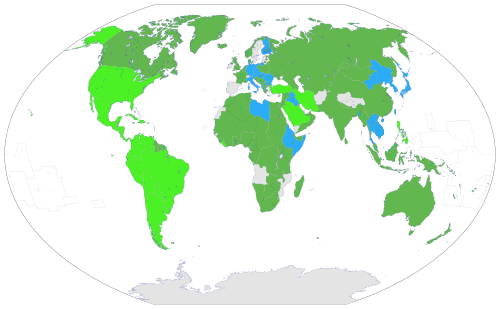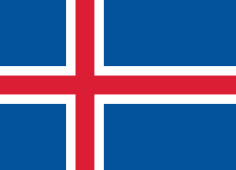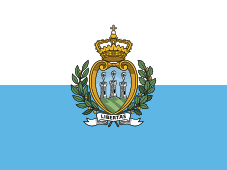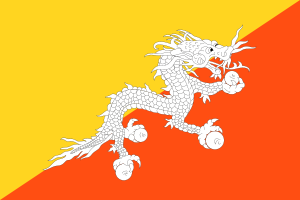Neutral powers during World War II
The neutral powers were countries that remained neutral during World War II. Some of these countries had large colonies abroad or had great economic power. Spain had just been through its civil war, which ended on 1 April 1939 (five months prior to the Invasion of Poland)—a war that involved several countries that subsequently participated in World War II.

During World War II, the neutral powers took no official side, hoping to avoid attack. However, Portugal, Sweden, and Switzerland all helped the Allies by supplying "voluntary" brigades to the United Kingdom, while Spain avoided the Allies in favor of the Axis, supplying them with its own voluntary brigade, the Blue Division. Ireland generally favoured the Allied side, as with the United States. The United States remained neutral until 8 December 1941, a day following the attack by Japan on Pearl Harbor.
The Lateran Treaty between Italy and the Vatican, signed in 1929, required that the Pope maintain "perpetual neutrality in international relations"—making the Vatican City a neutral state.
Several countries suffered invasions in spite of their efforts to be neutral. These included Nazi Germany's invasion of Denmark and Norway on 9 April 1940—then Belgium, the Netherlands, and Luxembourg on 10 May 1940. On the same day, 10 May 1940, the British, having already invaded the Faroe Islands in April, invaded Iceland and established an occupying force (subsequently replaced by the then-neutral United States). In the Baltic states, the Soviet Union invaded Lithuania on 15 June 1940 and Latvia and Estonia on 17 June. In the Balkans, the Italo-Greek War began on 28 October 1940 and Yugoslavia was invaded in April 1941. Iran was also attacked and occupied by Britain and the Soviet Union in August 1941.
See also the histories of Afghanistan, Andorra, Guatemala, Liechtenstein, Saudi Arabia and Yemen during this period.
Continent
Europe
Ireland

Portugal

Colonies of Portugal:








Spain
![]()
Operation Barbarossa removed the Mediterranean from the main theatre of war, causing a decline in Spain's interest in intervention. A decreasingly relevant Serrano Suñer was still able to create the Blue Division,[2] of volunteers to fight for the Axis. With the conflict decidedly turning towards the Allies, on 1 October 1943 Franco returned the status of Spain to one of "vigilant neutrality".[3]
Spain was a key provider of tungsten (a strategic metal) to Nazi Germany during the conflict; amid heavy diplomatic pressure from the Allies, the supplies decreased after the signing of a secret deal between Spain, the United States and the United Kingdom on 2 May 1944 that led to the fixing of a drastic limit on exports of tungsten to Germany and the ejection of German spies from Spanish soil.[4]
Sweden
![]()
In 1943, the Armed Forces of Sweden were much improved and all such deals with Germany were terminated. Hitler considered invading Sweden, but when Göring protested, Hitler dropped the plan. SKF supplied the majority of ball-bearings used in Germany, and were important also to Allied aircraft production. [5]
Swedish Intelligence cracked the Geheimschreiber, and shared decrypted information with the Allies. Stalin was informed well in advance about Hitler's planned invasion of the Soviet Union, but he chose not to believe the information.
Danish resistance worked with Sweden and effected the 1943 Rescue of the Danish Jews, shipping the Jews to Sweden. During the Liberation of Finnmark it sent Norwegian "police" troops over the border to link up with Allied forces. At the end of the war it was preparing to invade Norway and Denmark with the Allies should the occupying Wehrmacht forces have refused to accept a general armistice.
Switzerland

Lithuania

Latvia

Estonia

Iceland

Microstates
Andorra
Liechtenstein
Monaco

San Marino

Vatican City
Asia
Afghanistan
.svg.png)
Bhutan

Iran
.svg.png)
Saudi Arabia
.svg.png)
Turkey

- Turkey was an important producer of chromite, a strategic material for metallurgy to which Germany had limited access. The Germans wanted it, and the Allies wanted to prevent them getting it, so chromite was the key issue in Turkey's negotiations with both sides. Turkey halted its sales to Germany in April 1944 and broke off relations in August. In February 1945, after the Allies made its invitation to the inaugural meeting of the United Nations (along with the invitations of several other nations) conditional on full belligerency, Turkey declared war on the Axis powers, but no Turkish troops ever saw combat.
Yemen

Americas
Nicaragua
.svg.png)
United States

Conclusion
Portugal, Spain, Sweden, and Switzerland held to the concept of armed neutrality, and continuously amassed soldiers to defend their nation's sovereignty from potential invasion. Thus, they maintained the right to become belligerent if attacked while in a state of neutrality. The concept of neutrality in war is narrowly defined and puts specific constraints on the neutral party in return for the internationally recognized right to remain neutral. A wider concept is that of non-belligerence. The basic treaty covering Neutral states is Convention V of The Hague Respecting the Rights and Duties of Neutral Powers and Persons in Case of War on Land (1907). It is important to note that a neutral country takes no side in a war between other parties, and in return hopes to avoid being attacked by either of them. A neutralist policy aims at neutrality in case of an armed conflict that could involve the party in question. A neutralist is an advocate of neutrality in international affairs. The concept of neutrality in conflicts is distinct from non-alignment, i.e., the willful desistance from military alliances in order to preserve neutrality in case of war, and perhaps with the hope of preventing a war altogether.
In a study of Spain, Switzerland, and Sweden during the Second World War, Eric Golson found that they engaged in economic realpolitik, as they traded with both the Axis and the Allied Powers.[10]
See also
- Participants in World War II
- Allies of World War II
- Axis powers
- Declarations of war during World War II
- Latin America during World War II
References
- Egido León, Ángeles (2005). "Franco y la Segunda Guerra Mundial". Ayer. 57 (1): 105. JSTOR 41325295.CS1 maint: ref=harv (link)
- Egido León 2005, p. 116.
- Egido León 2005, p. 122.
- Moradiellos, Enrique (2016). "España y la segunda guerra mundial, 1939-1945: entre resignaciones neutralistas y tentaciones beligerantes" (PDF). In Carlos Navajas Zubeldia & Diego Iturriaga Barco (ed.). Siglo. Actas del V Congreso Internacional de Historia de Nuestro Tiempo. Logroño: Universidad de la Rioja. p. 72–73.
- Did Swedish Ball Bearings Keep the Second World War Going? Re‐evaluating Neutral Sweden’s Role
- Liekis, Šarūnas (2010). 1939: The Year that Changed Everything in Lithuania's History. New York: Rodopi. pp. 119–122. ISBN 978-9042027626.
- Neiburgs, Uldis. "Soviet occupation". Latvijas Okupācijas muzejs. Retrieved 17 December 2017.
- Estonian Neutrality Law of December lst, 1938
- Jan Romein (1962). The Asian Century: A History of Modern Nationalism in Asia. University of California Press. p. 382.
- Golson, Eric (2016). "Neutrality in War". Economic History of Warfare and State Formation. Studies in Economic History. Springer, Singapore. pp. 259–278. doi:10.1007/978-981-10-1605-9_11. ISBN 9789811016042.
- Karsh, E. "Neutrality and Small States." 1989.
- Gabriel, J. M. "The American Conception of Neutrality After 1941." 1989.
.jpg)